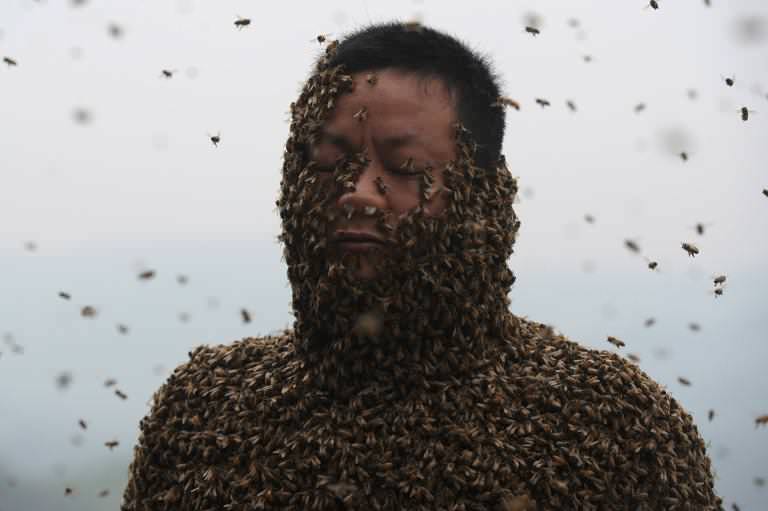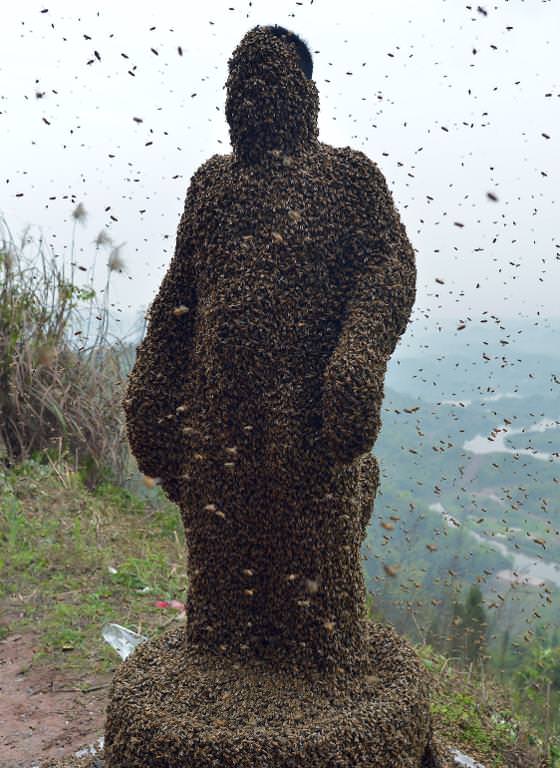Give bees a chance: Nine-year-old girl finds insects have made PEACE sign on honeycomb in father's apiary
- Nine-year-old Meesha Benefer found peace symbol in her honeycomb
- Symbol created by bees at the family bee farm in Leeds, West Yorkshire
A nine-year-old beekeeper was astonished to find that the insects in her father's hives had made a peace sign on a honeycomb.
Meesha Benefer, nine, found the symbol made by a colony at her father's bee farm in Leeds, West Yorkshire.
Her 38-year-old father Peter, who runs the beekeeping business on the side with the help of his young daughter said he was 'totally taken aback' when Meesha found the peace sign.
Buzz for peace: Meesha Benefer, nine, found a peace symbol in the honeycomb in her bee hive
Keen apiarist Meesha made the astonishing discovery while helping her dad at Benefer's Bee Farm in Leeds, West Yorkshire.
Meesha said: 'Every Saturday me and my dad go to the hives to check on the bees and always hope to see honey building up in the comb.
'It means I have to pull the big heavy frames out and if we are lucky and its the right time of year, we drain it together to collect honey to sell and have it in our porridge for breakfast.
'Last Saturday I was pulling out one of the frames and noticed there was a weird sign on one side.
'I thought it was the Volkswagen sign because I'd seen it before on my Grandad's car. But Dad was really amazed and said the circle with the three lines inside meant world peace.'
'Pollen' their leg: Meesha first associated the sign with that of Volkswagen, but was told of its true meaning by her father while they worked at the family bee farm
The father-daughter team have been running Benefer's Bee Farm for three years, and balance it on the side of schoolwork and Mr Benefer's job in recruitment.
Mr Benefer said: 'I was totally taken aback by the symbol that one of our colonies left in the honeycomb.
'Bees are known to be highly intelligent creatures and have very sophisticated means of communicating to each other.
'Obviously this is an incredible coincidence - but I have to say a little bit of me did wonder if they were trying to leave us a message.'
The avid aphiarist who spends his free time with daughter Meesha reading up on honey bees' behaviour, said: 'I've read all sorts of incredible things bees have been known to do, but never anything like this.
Family buzz-ness: Meesha and father Peter Benefer, 38, found the symbol while working on their apiarist business, Benefer's Bee Farm
'I've read lots of those stories about people seeing Jesus' face in slices of toast and their dead relatives in naan breads and whatnot, and I've always thought they're just a ploy for attention seekers.
'But when I saw this there's no way someone could have created that.
'Bees fill each cell in a piece of comb with honey and cap it off, but sometimes a few holes or large patches will just get missed and left uncapped.
'I'm amazed the they've missed out all the cells to make any sort of picture at all, let alone one which has a deep significance.'
Meesha, who stays with Peter at weekends after her parents separated, said they have kept the honeycomb to put in a frame on her bedroom wall.
Peter added the two would continue to run their farm in the Headingley area of Leeds, which produces honey for the city's Double Tree Hilton hotel.
ORIGINAL SOURCE: MAILONLINE.COM






















